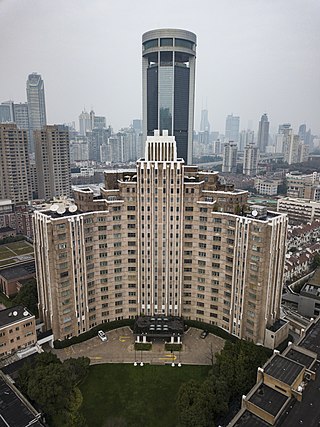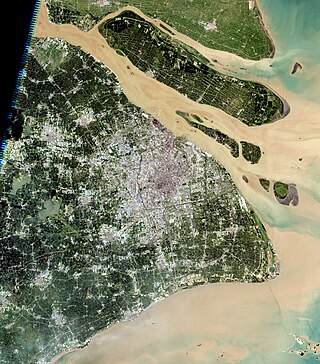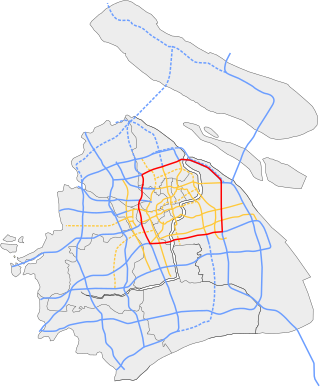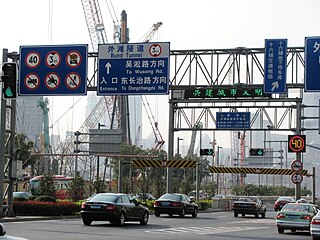Related Research Articles

The Bund is a waterfront area and a protected historical district in central Shanghai. The area centers on a section of Zhongshan Road within the former Shanghai International Settlement, which runs along the western bank of the Huangpu River in the eastern part of Huangpu. The area along the river faces the modern skyscrapers of Lujiazui in Pudong. The Bund usually refers to the buildings and wharves on this section of the road, as well as some adjacent areas. This region has a significant European influence, with the style of many structures most comparable to that of European cities, particularly Gothic, Baroque, Neoclassical, Romanesque, Art Deco, and Renaissance architecture. Additionally, some of the city's top eateries are located there. From the 1860s to the 1930s, it was the rich and powerful center of the foreign establishment in Shanghai, operating as a legally protected treaty port.

Hongkou is a district of Shanghai, forming part of the northern urban core. It has a land area of 23.48 km2 (9.07 sq mi) and a population of 757,498 as of 2020. The district borders Yangpu to the east, Pudong to the southeast, Huangpu to the southwest, Jing'an to the west and Baoshan to the north.

The Confucian Temple or Temple of Confucius of Shanghai, is a folk Confucian temple in the old city of Shanghai. It is similar to the original temple of Confucius in his hometown Qufu and to the Beijing temple, but on a smaller scale. The temple is located on Wenmiao Road in Huangpu District.

Shanghai has around 2000 formal bus lines, served by more than 10 bus companies. In the past, Bashi, Dazhong, Guanzhong and Qiangsheng were the four largest; around 2009 they merged to become Bashi Group Companies, including Bashi No.1-6 Bus Passenger Service Companies, Bashi Tram, Bashi Xinxin and Chongming Company, Baoshan Company and Jinshan Company. Each Suburban district also renewed with one company serving each district. Around 2015, Bashi No.1 Passenger Service and Bashi Tram merged to be Bashi No.1 Company, Bashi No.2 Passenger Service became Bashi No.2 Company, Bashi No.3, No.4 Passenger Service merged to be Bashi No.3 Company, Bashi No.6 Passenger Service became Bashi No.4 Company, and Bashi No.5 Passenger Service and Baoshan Company became Bashi No.5 Company.

Shanghai Jinjiang Hotel (上海锦江饭店) is a for-profit hotel in Huangpu, Shanghai, China. The hotel is operated by Jin Jiang International (Holdings) Co., Ltd.

South Xizang Road is the name of an interchange station between Line 4 and Line 8 of the Shanghai Metro. It began operation on both lines on 29 December 2007. On 22 October 2010 the station handled about 100,000 entries and exits. It is the first station in Huangpu District when travelling northbound on Line 8.

The Shanghai Natural History Museum is a museum dedicated to natural history in the city of Shanghai. It is one of the largest museums of natural sciences in China. Formerly housed in the Shanghai Cotton Exchange Building, the museum was moved to a purpose-built site in the Jing'an Sculpture Park in 2015.

Line 10 is a southwest–northeast line of the Shanghai Metro network that opened for service on April 10, 2010. The line runs from Jilong Road to Hongqiao Railway Station, with a branch line from Longxi Road to Hangzhong Road. It has been given the unofficial nickname “Golden Line” as it links many of the city's tourist attractions like Yuyuan and Xintiandi. It connects the Hongqiao International Airport with the downtown core of Shanghai, and also the dense residential districts of Yangpu and Hongkou. It is the only line in the system with numbered station codes. It is the first high-density and high-volume fully automatic subway line in Mainland China, operating with GoA4 unattended train operation. The line is colored lilac on system maps.

Line 11 is a northwest–southeast line of the Shanghai Metro network. Since October 2013, Line 11 serves Kunshan city, making it is the second intercity metro in China after the Guangfo Metro and the first that crosses a provincial boundary. With a single-line mileage of 82.386 kilometres (51.192 mi), it is the third-longest single-line subway line in China, after Line 6 in Chongqing, which is 85.6 km (53.2 mi) long and Line 7 in Wuhan with a length of 83.6 km (51.9 mi). The line is colored brown on system maps.

The Shanghai Yangtze River Tunnel and Bridge is a bridge–tunnel complex across the south fork of the Yangtze River near the river mouth in Shanghai. The tunnel connects the Pudong District of Shanghai on the south bank of the river with Changxing Island, while the bridge connects Changxing Island with Chongming Island. In combination with the Chongqi Bridge, which connects Chongming Island to the north bank of the Yangtze, the bridge–tunnel complex forms the final crossing of the Yangtze before it empties into the East China Sea.

The geography of Shanghai is characterised by its location on the Yangtze River Delta on China's east coast and its proximity to the Pacific Ocean via the East China Sea. The city is centred on the Huangpu River, a tributary of the Yangtze River, and extends outwards in all directions, with the suburbs and satellite towns reaching east to the East China Sea, north and west to Jiangsu province, and south to Zhejiang province over Hangzhou Bay.

The Shanghai Outer Ring Expressway, designated S20, is a ring expressway that surrounds the inner districts of the city of Shanghai, China.

Inner Ring Road, also known as Inner Ring Elevated Road, is an elevated expressway loop in the city of Shanghai. It was the first ring road around the city of Shanghai. The Puxi section of the road was completely grade-separated and complete in 1994, while the Pudong section of the road was completely grade-separated in 2009. Before the grade separation in Pudong, the road ran at street level, with traffic lights at intersections.

The Power Station of Art is a municipal contemporary art museum in Huangpu, Shanghai, China. The museum is a public institution funded by the Shanghai City Culture and Tourism Bureau.
In early March 2013 over 16,000 dead pigs were found in the Shanghai Songjiang section of the Huangpu River, which supplies the city of Shanghai, China with some of its drinking water. The pigs were dumped by farmers in neighbouring Jiaxing, Zhejiang province, a major pig farming area that is upstream of Shanghai.

The Bund Tunnel is a 3.3 km (2.1 mi) sub-surface road and road tunnel in the city of Shanghai, China. The tunnel connects the districts of Hongkou to the north and Huangpu to the south.

The Dapu Road Tunnel, formerly Huangpu River Tunnel or Project 651, is a road tunnel that runs under the Huangpu River in the city of Shanghai, China. It connects Huangpu District on the Puxi side of Shanghai with Pudong New Area. It consists of two tubes, the first of which was constructed between 1965 and 1970 and acted as the first vehicular tunnel underneath the Huangpu River in. The tunnel has two lanes and originally operated with one lane in each direction. Due to the need for greater capacity brought on by Shanghai's Expo 2010, a second tube was built between 2009 and 2010 just to the west of the first, opening on February 11, 2010. When the second tube opened, the first tube was converted for northbound traffic only while the new tube carried southbound traffic. The east, northbound tube is 2.739 km (1.702 mi) in length, while the west, southbound tube is 2.971 km (1.846 mi) long.

The Shanghai Ferry is a system of ferry routes across the Huangpu River in Shanghai. The ferry service started on January 5, 1911 by the municipal authorities in Pudong. Before the 1970s, the ferry service was the only way to cross the Huangpu River. In the 1980s, the Shanghai Ferry became one of the busiest ferry services in the world. In the 1990s, as bridges and tunnels across the Huangpu river were built, the ferry service saw a sharp drop in ridership. The Shanghai Ferry currently consists of 18 ferry lines and is operated by the state-owned Shanghai Ferry Company.

The Yangshupu Waterworks is a waterworks built in 1883, and located at 830 Yangshupu Road (杨树浦路830号) in the district of Yangpu, Shanghai, China. The waterworks was the first of its kind to be built in China and provided running water for the first time to some of the cities' residents. It belongs to the Shanghai Water Company and occupies a site of 32 acres and has four major lines of tap water allowing for a maximum capacity of around 1.5 million cubic metres a day. In 2009 it supplied 400 million cubic metres of water, about 20% of the total water supply of Shanghai.

Airport link line of Shanghai Suburban Railway is a commuter rail line currently under construction in Shanghai. It runs from Hongqiao Airport Terminal 2 in Minhang District to Shanghai East railway station in Pudong. The 68.6-kilometer (42.6 mi) express line is expected to shorten the travel time between the airports of Hongqiao and Pudong from 90 minutes to under 40 minutes. Construction started in June 2019. The line is expected to open at the end of 2024.
References
- ↑ "上海外环隧道通车" (in Chinese). xinhuanet.com. 2003-06-22. Archived from the original on 2004-12-13. Retrieved 2009-07-16.
- ↑ "上海S20外环隧道将大修:3月22日起全封闭施工,计划工期12个月". 澎湃新闻 (in Chinese). 2024-03-14. Retrieved 2024-03-14.
31°22′44″N121°30′00″E / 31.3788°N 121.4999°E